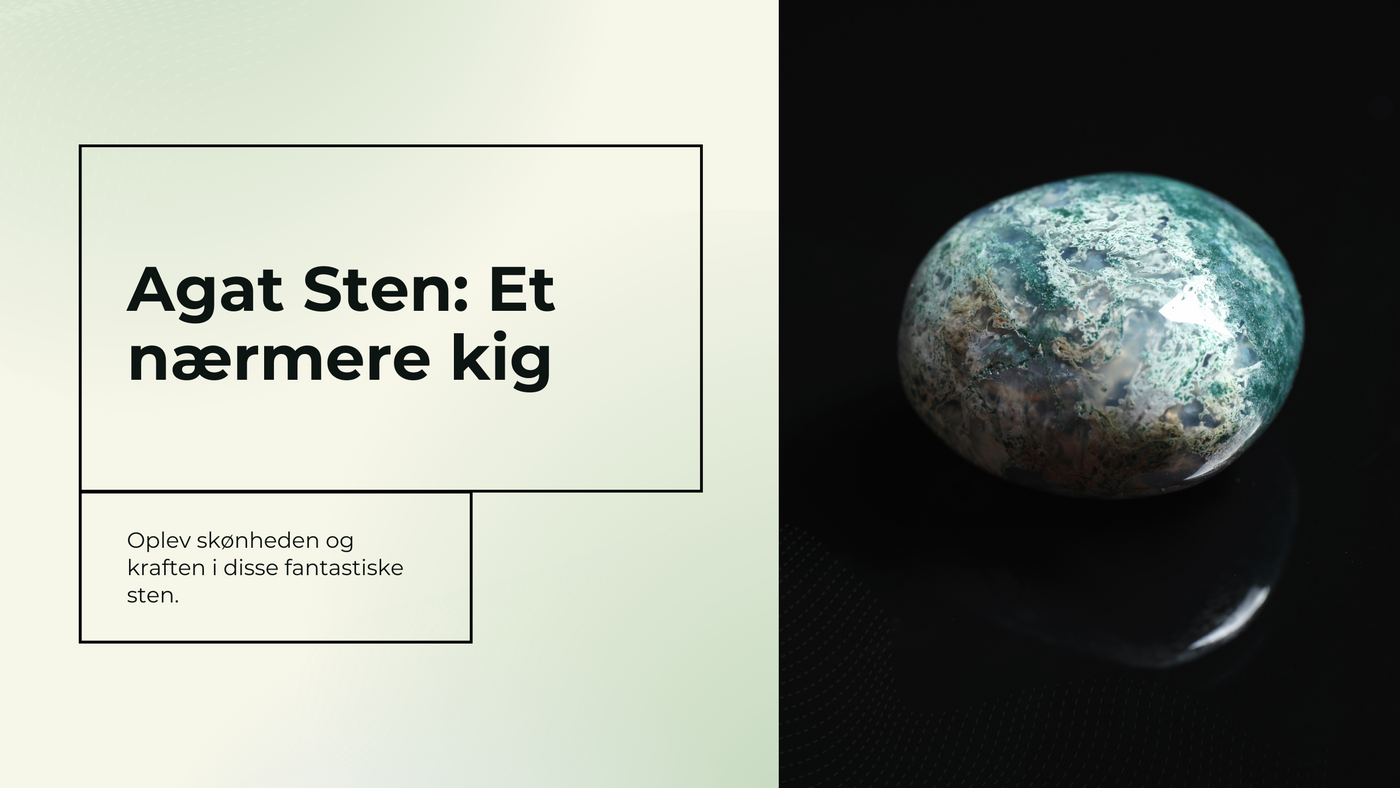
Agate
Agate stone - a semi-precious stone that is not only beautiful, but also full of history and meaning. In this post, we delve into the enchanting world of agate and explore its many facets: from its geological formation and diverse appearance to its cultural significance throughout the ages.
Agate is more than just a gemstone; it is a tale of nature's work of art and man's ability to transform this raw beauty into something even more breathtaking. So whether you love working with agate in your jewelry making, are a collector, or simply curious to learn more about the history and properties of this colorful stone, you've come to the right place. Let's embark on this journey of discovery together and explore all that agate has to offer.
Three quick things about agat
Unique properties and formation: Agate is a type of chalcedony, a form of quartz, and is characterized by its layered structure that creates bands of color and transparency. Agate forms in cavities in ancient volcanic rocks, and it can take up to 50 million years for an agate to form.
Historical Significance: Agate has been used and valued for thousands of years. It was first found on the Achates River in Sicily, which gave it its name. In various cultures, agate has been used for its supposed protective and healing properties. For example, it was often worn by ancient sailors as amulets, believing that they protected against danger. Agate has also been used in the art of hard stone carving, with artifacts dating back to ancient Mesopotamia.
Metaphysical Properties: Agate is often associated with balance, stability and strength. It is considered a grounding stone with a stabilizing and strengthening effect.
Agate:A semi-precious stone with historical and cultural richness
A journey through time: Agate's history is as colorful as the stone itself, stretching back over 3,000 years. The popularity of this semi-precious stone began to grow, and one of the reasons for that is due to its properties of protection, strength and healing.
Treasure of the past: In the Renaissance, agate gained a special place in the hearts of Europeans. Skilled craftsmen of this era transformed agate into unique works of art, large and small, highlighting its alluring beauty and versatility.
A cultural connection: Throughout history, agate has been an important part of many cultures. In ancient Babylon it was used to create protective amulets. The Mesoamerican people valued it for its role in ceremonial masks and other artefacts. Agate's unique patterns and colors have always been associated with myths and legends that have often been about fertility, harmony and protection against negative energies.
Today's Spirituality and Healing: In modern times, agate has become an integral part of spiritual practices and holistic healing. Its inherent beauty and metaphysical properties continue to inspire and enrich lives around the world.
Cultural and historical heritage: The earliest known carved agates originate from Mesopotamia. Both the Greeks and Romans recognized the value of agate, using it in signet rings and tableware. Today, agate is still a favorite among stonemasons, due to its appeal and continued demand/popularity among people worldwide.

Where does agate come from?
Worldwide distribution: Agates are found in many different parts of the world. Here is an overview of some of the most notable agate mines:
USA: With large deposits of agate, the United States is one of the leading sources of this semi-precious stone. The country's geological diversity contributes to a wide selection of agate types.
Brazil: Known for its rich collection of agate types and colors, Brazil is a significant producer of agate. Brazilian agate is recognized for its unique beauty and quality.
Mexico: Mexico is particularly famous for its production of fire agate, a unique type of agate that is highly sought after due to its unique appearance and rarity.
India: India contributes to the agate industry with various varieties, including colorful and banded agates, which are often used in jewelry making.
Agate types and their meanings
A spectrum of agate types: The agate gemstone comes in a multitude of types, each with its own unique characteristics and meanings. Here is an overview of some of the most common agate types:
Blue Lace Agate: This type of agate is known for its calming properties. It is often associated with communication and spiritual growth, making it popular among those seeking inner peace and clarity.
Botswana Agate: This variant is said to offer stability and protection. It also promotes creativity and emotional healing, making it ideal for personal growth and artistic inspiration.
Crazy Lace Agate: Known for its association with joy, vitality and optimism. It is often used to promote laughter and balance in life, giving it a special place in many hearts.
Dendritic Agate (The Stone of Abundance): This agate is synonymous with abundance, prosperity and growth. It is often used to attract positive energy and promote personal development.
Fire Agate also known as Fire Agate: Associated with courage, protection and strength. It is said to ward off negative energy, making it a powerful stone during challenging times.
Strip Agate also known as Fortification Agate: Known for its characteristic band pattern. This agate is often used to create stability and grounding, helping to keep the feet firmly planted on the ground.
Iris Agat: This type is associated with hope, balance and positive energy. It is said to be helpful in overcoming challenges, making it a stone filled with optimism.
Moss Agate: This agate is closely linked to nature and symbolizes abundance and healing. It is said to improve emotional balance and stamina, making it a stone of calm and resilience.
Each type of agate gemstone has its own special charm and meaning, making them more than just beautiful stones; they are symbols of various aspects of human life and nature.
Value and variations of agate stone
General value: The value of the agate gemstone varies depending on the type and is often modest. This value typically reflects more the work and craftsmanship involved in processing the stone than the material itself. This also means that the Agate stone is an affordable choice for many who value natural beauty.
Factors affecting the price: The value of an agate stone depends on a number of factors. Color, pattern, rarity and demand all play a role in determining a stone's value. Some varieties of agate can fetch higher prices in the market due to their unique qualities and appearance. Eg. agates that are large in size or have distinctive, fine or landscape-like color patterns can fetch higher prices. Their unique and captivating visual appeal makes them more desirable. Similarly, stones from special collectible locations are also more valuable due to their uniqueness and rarity.
Price range: The price of agate stone can vary considerably. For the natural agate, prices start from a few dollars. However, special types such as Blue Lace Agate, Moss Agate, Dendritic Agate and Feather Agate can reach hundreds of dollars. These types are prized for their rare and striking characteristics.
Unique characteristics and rarity: It is the unique features and rarity of certain agate types that most often affect their value. Top quality and rare agates, which are harder to find, are naturally priced at some higher prices due to their exclusivity.
The most popular varieties today
There are also other types of agate that catch the attention of collectors and enthusiasts. Iris Agate, Dendritic Agate, Blue Lace Agate, Moss Agate and Indian Agate are each sought after for their unique characteristics and beauty.
With us you will find all three variants right here:
Blue Lace Agate: click here
Indian Agate: click here
Moss Agate: click here
The world of the agate stone is full of variations and types, and its many shapes and colors give us jewelry enthusiasts exciting possibilities when it comes to jewelry creations.
How to identify an agate stone
Characteristics and composition: Agate stones are part of the chalcedony family, a group that includes various jewelry stones such as aventurine, bloodstone, carnelian, chrysoprase, jasper and onyx. Agate is known for its distinct band patterns, which give it a unique identity within the semi-precious stone world.
Appearance and transparency: Agate stands out with its different levels of color and transparency. The stones can be more or less transparent, depending on their specific band. These bands show clear layers, some of which may be more opaque than others, adding depth and character to the stone.
Colors and patterns: The colors and patterns in an agate stone are developed through various geological processes. These include the rock's geochemistry, groundwater content, pH levels, time frames for crystallization and geological activity. These factors contribute to creating a wide range of colors and patterns, making each agate stone unique.
Popular Types of Agate: There are many different types of agate, each with its own characteristics and colors. Some of the most well-known types include:
Blue Lace Agate: Known for its soothing blue color.
Botswana Agate: Often has fine bands and a natural aesthetic.
Crazy Lace Agate: Is characterized by its complex and colorful patterns.
Dendritic Agate: Known as the Stone of Abundance, with tree-like patterns.
Fire Agate: Has a flame-like radiance and play of colors.
Stripe Agate Or Fortification Agate: Characterized by its distinct band pattern.
Iris Agate: Emits different colors, just like an iris.
Moss Agate: Similar to moss or landscapes in its texture and color.
Onyx Agate: Known for its deep, monochromatic tone and elegance.
Each type of agate offers its own unique beauty and charm, making them a fascinating and versatile gemstone for collectors and jewelry enthusiasts.
Why is agate suitable for jewellery?
Strength and Durability: Agate has an impressive hardness of 6.5 - 7 on the Mohs scale. This indicates that the agate has a moderate to high hardness. This also means that the semi-precious stone is strong enough to withstand everyday wear and tear without losing its beauty.
Suitable for different jewelry: Thanks to its robust nature, agate is ideal for being incorporated into a wide range of jewellery. This stone is perfect for rings, which are often exposed to more wear and tear than other jewelry. It also adds a unique charm to pendants, earrings and bracelets, where its durability ensures that the jewelery can be worn and enjoyed for many years.
Color and shape: Agate's diversity in color and shape gives designers the freedom to create both bold and understated jewelry designs. This stone can adapt to a wide range of tastes and styles, making it a versatile companion in the jewelry world.
A palette of design options: Agate's unique aesthetic appeal brings a special charm to one's jewelry. Thanks to its many shapes, colors, patterns and types, agate stone is the perfect addition to e.g. elegant pendants, rings, bracelets and necklaces - the agate adds a touch of nature's art to every jewelery creation.
How to clean and maintain agate
Use warm soapy water: To clean agate gemstones, it is recommended to use lukewarm, soapy water and a soft brush. This is gentle and effective in removing dirt and grease.
Avoid harsh chemicals: It is important to avoid harsh chemicals when cleaning agate gemstones as these can damage the surface or finish of the stone.
Dry the stone thoroughly: After cleaning, the stone and any settings must be thoroughly dried before the jewelery is stored or worn again. This prevents water damage or stains.
Protect from sun and heat: Avoid prolonged exposure to direct sunlight and extreme temperatures, as this can affect the colors and quality of the agate.
Storage: It is best to store agate jewelry in a fabric-lined box or wrapped in a soft cloth. This prevents scratches and damage to the stone.
Thank you for your time!
I hope you learned something from today's blog post. If nothing else, I hope you found the post interesting.
It was great that you bothered to read along!

Andreas Bruhn
Uniq Pearls
